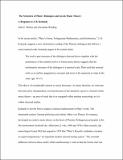| dc.contributor.author | Mckay, John Z. | |
| dc.contributor.author | Rehding, Alexander | |
| dc.date.accessioned | 2014-08-11T16:36:43Z | |
| dc.date.issued | 2011 | |
| dc.identifier.citation | Mckay, John Z., and Alexander Rehding. 2011. “The Structure of Plato’s Dialogues and Greek Music Theory: A Response to J. B. Kennedy.” Apeiron 44, no. 4. | en_US |
| dc.identifier.issn | 0003-6390 | en_US |
| dc.identifier.uri | http://nrs.harvard.edu/urn-3:HUL.InstRepos:12712855 | |
| dc.description.abstract | J. B. Kennedy recently proposed a radical new interpretation of the Platonic dialogues, arguing that their stichometric structure is based in a Greek twelve-tone musical scale. We explore to what extent such an interpretation might be borne out historically by Greek music-theoretical traditions: the concept of scale, the significance of number 12 (on which Kennedy's theory is anchored), conceptual differences between Harmonicists and Pythagoreans, and the applicability of Kennedy's scale within the context of Plato's thought. While the statistical correlations Kennedy notes are intriguing, their foundation in Greek music-theoretical traditions proves problematic. | en_US |
| dc.description.sponsorship | Music | en_US |
| dc.language.iso | en_US | en_US |
| dc.publisher | Walter de Gruyter GmbH | en_US |
| dc.relation.isversionof | doi:10.1515/apeiron.2011.021 | en_US |
| dash.license | OAP | |
| dc.subject | J. B. Kennedy | en_US |
| dc.subject | Greek music | en_US |
| dc.subject | Plato | en_US |
| dc.subject | Pythagoreans | en_US |
| dc.subject | scale | en_US |
| dc.title | The Structure of Plato's Dialogues and Greek Music Theory: A Response to J. B. Kennedy | en_US |
| dc.type | Journal Article | en_US |
| dc.description.version | Accepted Manuscript | en_US |
| dc.relation.journal | Apeiron | en_US |
| dash.depositing.author | Rehding, Alexander | |
| dc.date.available | 2014-08-11T16:36:43Z | |
| dc.identifier.doi | 10.1515/apeiron.2011.021 | * |
| dash.contributor.affiliated | Rehding, Alexander | |


